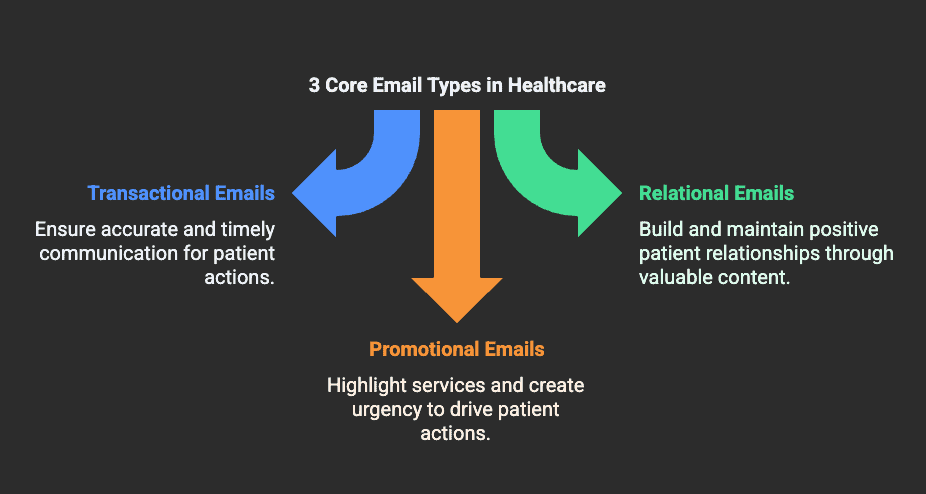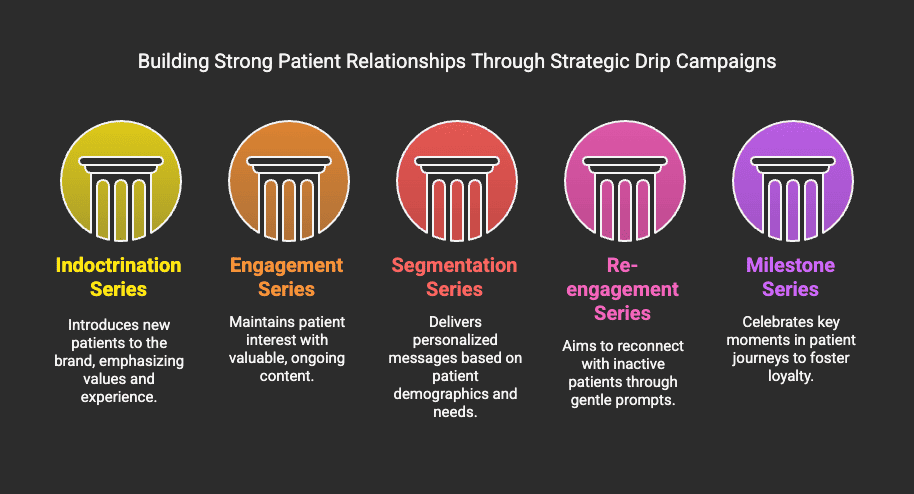Did you know that email marketing yields an average 4200% ROI? That’s $42 for every $1 spent. Yet in the healthcare industry, where building trust and maintaining patient relationships is essential, many organizations still struggle to implement effective email strategies.
Healthcare marketers face unique challenges, from building patient trust to ensuring seamless, compliant communication. A strategic drip email campaign can significantly enhance patient relationships, increase conversions, and foster lasting loyalty. When carefully crafted, these campaigns can transform routine communications into meaningful connections that empower and engage patients.
Why Drip Campaigns Matter in Healthcare Marketing
Drip campaigns provide healthcare brands with an opportunity to send timely and relevant messages, carefully spaced and tailored to the patient’s journey. By delivering personalized information at critical moments, these campaigns nurture patient relationships, promote education, and drive consistent engagement. Patients who regularly receive thoughtful communications feel more valued, informed, and connected to their healthcare providers.
Understanding the 3 Core Email Types in Healthcare
When thinking about email marketing strategies, it can initially feel overwhelming. However, breaking down email communications into clear categories can simplify the process and help marketers build structured, impactful campaigns. By categorizing emails, healthcare marketers can better focus their messaging, optimize their workflow, and enhance patient engagement and satisfaction.
1. Transactional Emails: Your Reliable Messengers
Transactional emails are automated messages triggered by specific patient actions or interactions with your brand. Common examples in healthcare include appointment confirmations and reminders, prescription renewal notifications, and account-related communications such as password resets. These emails are crucial because patients rely heavily on their accuracy and timeliness to manage their healthcare needs effectively.
2. Relational Emails: Your Relationship Builders
Relational emails focus on nurturing a positive, ongoing relationship with your patients by providing valuable, informative content without pushing direct sales. Examples include monthly health newsletters, inspirational patient success stories, or educational series tailored to specific medical conditions. To succeed, relational emails must remain engaging, educational, and genuinely valuable to recipients, reinforcing trust and connection.
3. Promotional Emails: Spotlighting Your Services
Promotional emails highlight your healthcare offerings, special events, or limited-time opportunities. They are designed to clearly communicate the benefits of specific healthcare services or programs, prompting patients to take action. Effective promotional emails typically include clear messaging, visually appealing layouts, and a sense of urgency that encourages immediate response, such as seasonal wellness packages or exclusive discounts on health checkups.

5 Highly Effective Drip Campaigns Every Healthcare Brand Should Have
1. Indoctrination Series: Welcome to Our Family!
An indoctrination series introduces new subscribers or patients to your healthcare brand, highlighting your team, values, and the patient experience. Typically, this involves a warm welcome email, an introduction to key care providers, and tips on optimizing their patient journey. In my opinion, this is one of the most important journeys you can create as it id the first 1-to-1 marketing communication this person will receive from you, so take your time and make it impactful and exciting.
2. Engagement Series: Stay Connected!
Engagement series emails maintain ongoing contact by consistently delivering meaningful and valuable content. These may include weekly wellness tips, condition-specific insights, or inspiring patient testimonials. Such emails keep patients actively involved and foster deeper engagement with your healthcare services.
3. Segmentation Series: Personalized Care Matters!
Segmentation campaigns deliver targeted messages tailored to specific patient groups based on demographics, health conditions, or interests. For instance, you might create specialized email series focused on diabetes care management, heart health education, or age-specific preventive measures, ensuring patients receive highly relevant communications.
4. Re-engagement Series: We Miss You!
Re-engagement emails aim to reconnect with inactive or disengaged subscribers by gently prompting renewed interest and interaction. Strategies include friendly check-ins, invitations to update preferences, or offering exclusive incentives or special content designed to rekindle patient relationships.
5. Milestone Series: Celebrating Patient Progress
Milestone series emails recognize and celebrate key moments in a patient’s healthcare journey, reinforcing positive engagement and strengthening the relationship between your brand and your patients. These emails might acknowledge achieving health-related goals, celebrate anniversaries of treatment or care initiation, or highlight progress in managing chronic conditions. By thoughtfully recognizing these personal milestones, healthcare brands can foster deeper patient loyalty, promote continued wellness, and encourage long-term engagement.

Real-World Success: My Diabetes Tutor Case Study
We partnered with My Diabetes Tutor, an educational support group for diabetic patients, to measure how structured email communication impacts patient engagement. By comparing two groups—those receiving targeted drip campaigns and those who received no emails—the results were striking. The group receiving emails demonstrated a significantly higher conversion rate of 63.3%, compared to just 26.3% in the control group. Additionally, the email group participated in more education sessions, initiated their first session far sooner, and maintained a shorter average duration between sessions. These results clearly illustrate the value and effectiveness of a thoughtfully executed email drip campaign.
Want to read through the full case study? Visit this page: Case Study: CRM Setup and Marketing for MyDiabetesTutor

Putting It All Together: Your Action Plan
Now that we’ve covered the fundamentals of healthcare email marketing, here’s a step-by-step action plan to implement or improve your own program:
- Audit your current email program or establish baseline goals if you’re just starting
- Map your ideal patient journeys for key segments of your audience. If you don’t have an idea of where to start, I recommend starting with an indoctrination series, as it is probably one of the most impactful series you will create.
- Create or refine your email templates to ensure they’re on-brand and effective
- Develop your core campaigns (start with indoctrination and one engagement sequence) – Begin writing impactful copy that will engage your audience
- Set up your automation in Zoho or your preferred email platform
- Establish your measurement framework to track results
- Launch, measure, and optimize based on performance data
Remember that email marketing is never “set it and forget it.” The most successful programs continuously evolve based on patient feedback, engagement metrics, and healthcare trends.
Ready to Elevate Your Email Marketing?
If you’re looking to develop strategic drip campaigns, set up effective automations, or craft compelling content, we’re here to help. At Well-Oiled Marketing, we specialize in creating personalized, compliant, and engaging healthcare email marketing campaigns. Ready to elevate your healthcare email marketing? Get in touch with our team today!






























































































